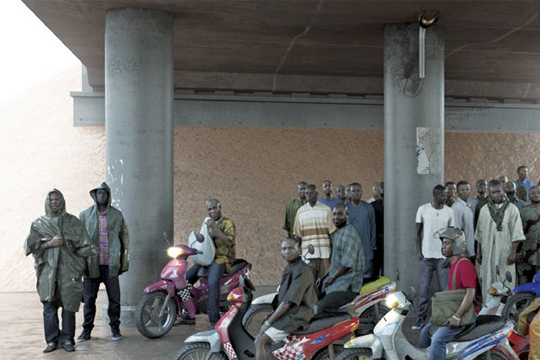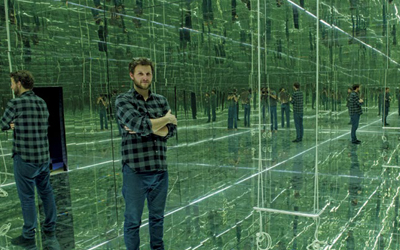SHARJAH BIENNIAL 11: RE:EMERGE, TOWARDS A NEW CULTURAL CARTOGRAPHY
| July 17, 2013 | Post In LEAP 21

Single-channel video projection, HD animation, color, silent, duration endless
Courtesy of the artist and galleries Hauser & Wirth, Yvon Lambert, Micheline Szwajce
Relationships start with a choice: to open up to a stranger or recoil. That choice, common as it is in encounters between individuals, is just as relevant when thinking about cultures coming into contact with one another—when friendship becomes a matter of war and peace. These meetings might produce a cacophonous event: like the 2011 Sharjah Biennial, which became embroiled not only in the politics of the Arab Spring, but in the expectations placed on a conservative Gulf state from a (neo)liberal West. But sometimes, a momentary polyphony is produced. The 2013 Sharjah Biennial 11, “Re:emerge, Towards a New Cultural Cartography,” is one such moment.
Curated by Yuko Hasegawa and presenting 99 artists in total, this biennial enacts a geographical focus on the “Global South”— a break from the West. It feels like a response to the previous Sharjah Biennial 10, which hangs over SB11 like a phantom elephant. On the opening day of SB10 in 2011, protests took place against the Gulf Cooperation Council (of which the UAE is a member) sending troops to violently suppress mass protests in Bahrain. People were arrested. Jack Persekian was fired (for presenting a blasphemous work by Mustapha Benfodil outside an Iranian mosque, ironically titled It is of No Importance). In Abu Dhabi, the “Guggenheim Boycott”—a global petition signed by artists demanding better working conditions on Saadiyat Island—was well underway. The global spotlight was on the UAE and its dubious political practices.
In 2012, Hu Fang discussed the garden as a spatial metaphor during the annual Sharjah March Meeting, which in turn explored the currency of art essentially as a form of cultural diplomacy. At the time, Hasegawa was also conceptualizing her own approach to the Islamic courtyard garden, using the Alhambra as a thematic focus. The inclusion of one work in “Re:emerge,” produced by Olafur Eliasson in collaboration with Vitamin Creative Space (of which Hu Fang is creative director), presents a conceptual link to last year’s discussions. Titled Your Embodied Garden (2013), Eliasson’s video explores the garden as a metaphor for the relation between the body and its surroundings. Meanwhile, Yang Fudong’s aptly titled Push the door softly and walk in, Or just stay standing where you are (2013), produces a relational geography between the locales of Alhambra and Sharjah, a relation exploring global convergence and divergence.
But some were unconvinced by Hasegawa’s reconciliatory courtyard proposal, even though it was a good motif to invite a different engagement: when “guests” enter a sovereign space and consider its particular contexts. It was a line drawn in the sand with a clear message: step in or step back, but gain perspective. This conceptual (and political) re-spatialization was accompanied by the completion of the Sharjah Art Foundation’s new complex of pristine, white cube art spaces modeled against the traditional architecture of the heritage and the arts areas where the biennial is staged. Despite a guidebook, a catalogue, and a map, being here alone was a way-finding experience in itself: a walk into unfamiliar territories and contexts. Viewed from above, the whole area, dubbed “The Heart of Sharjah,” is a labyrinth, an “angular orgasm” of spaces joined by corridors and courtyards, peppered with traditional stone buildings either restored, rebuilt, under construction, or in ruins.

Courtesy of the artist
In this, the courtyard garden theme marks a turn: a calculated reorientation. In many ways, the focus was on Sharjah’s historical legacy as a trading post in relation to its contemporary migrant community. CAMP’s From Gulf to Gulf to Gulf (2009-13), here seen as a popular outdoor screening, presents the lives of migrant workers from across the Gulf region; Apichatpong Weerasethakul and Chai Siri’s Dilbar (2013) portrays the life of a Bangladeshi city builder living in the UAE; and Superflex’s The Bank (2013) was a carpark transformed into a public playground using elements created from suggestions made by the local community: a literal middle ground between the two major sections of the biennial, where the public, private, local, and global intermingle and pass.
Some might say this made “Re:emerge” tranquil— or tranquilizing. Some criticized a political lack, though in the Islamic Bank Building, subtle agitations were to be found floor upon floor. There was Sarah Abu Abdallah’s Saudi Automobile (2011)—a video of her painting an unusable car pink, presented behind the car itself—and David Claerbout’s Oil workers (from the Shell company of Nigeria) returning home from work, caught in torrential rain (2013). But in terms of statements it was Shimabuku’s Boat Trip that was this biennial’s “end point”—as Hasegawa announced on the opening day. Visitors were invited to ferry across Sharjah Creek on a worker’s boat and eat salt or pepper ice cream on the other side. It was an encounter between seemingly incompatible things—ice cream with salt or pepper, or a global biennial tourist with a migrant laborer (or, what critic Nat Muller describes as a “laboring other”).
All in all, this was an exhibition geared towards relation and recognition. It was joyful, like the experience of Thilo Frank’s Infinite Rock (2013), a fantastical mirror room with a swing waiting to be sat on. And also difficult, like Amar Kanwar’s The Sovereign Forest (2012), a harrowing archival project presented at Documenta 13. In The Prediction (1991-2012), a beautifully bound book over which a projector beams pictures onto the surface of blank pages, the reader is told the story of the assassination of Shankar Guha Niyogi, leader of the Chhattisgarh Mukti Morcha (CMM)—a mass organization (labor union) of workers, peasants, and tribals that formed out of the mining region of Chhattisgarh. “I believe this world can be beautiful,” he is quoted as he predicts his own death. His words are printed in white on a black page.
In these encounters with other histories, realities and representations, a figurative cleansing takes place. In Wael Shawky’s ceremonial Dictums 10: 120 (2013), a ritual purification is invoked, as 32 qawwali singers perform sections of curatorial texts from previous Sharjah Biennials in Urdu, the most common language in Sharjah. Dictums was soothing, like the watery mist that filled a courtyard space in Shiro Takatani’s Fog Machine (2013). It was playful, like the playground figures installed outside two exhibition venues with their eyes, mouths or ears taped over with duct tape in Miki Kasahara’s Theme Park (2011-12). It was gentle, like the shade produced by OFFICE, Kersten Geers and David Van Severen’s various (and literal) Oases, and peaceful, like the pebbled courtyard garden produced by Otobong Nkanga in Taste of Stone (2013). It also invoked the release of wild and well-intentioned abandon as seen in Jesper Just’s video No Man is an Island (2002), in which a man dances around a city plaza so as to coax a smile out of a forlorn and broken romantic.
“Re:emerge” recalled rule number 13 in Basim Magdy’s video work, 13 Essential Rules for Understanding the World (2011), presented at Bait Al Serkal: “Don’t forget there are almost 7 billion other people here.” It reflected the sentiments of Angelica Mesiti’s four-channel video installation Citizen’s Band (2012): four migrants living in Paris or Australia, each performing a song. There was a Cameroonian water-percussionist drumming the surface of a swimming pool; the haunting sounds of Algerian Raï on the subway; a Mongolian throat song outside a convenience store; and Sudanese folk whistled in a taxicab. These call for a working polyphony: multiple forms of expression united in a complex web of contexts. Like Tarek Atoui’s Within— drummers engaging in long, riveting sessions of composed (and at times cacophonous) improvisation— they gave sense to Sharjah Biennial 11’s rhyme and reason. Unlike most new cartographic agendas, this was a love song, not a call to arms.

